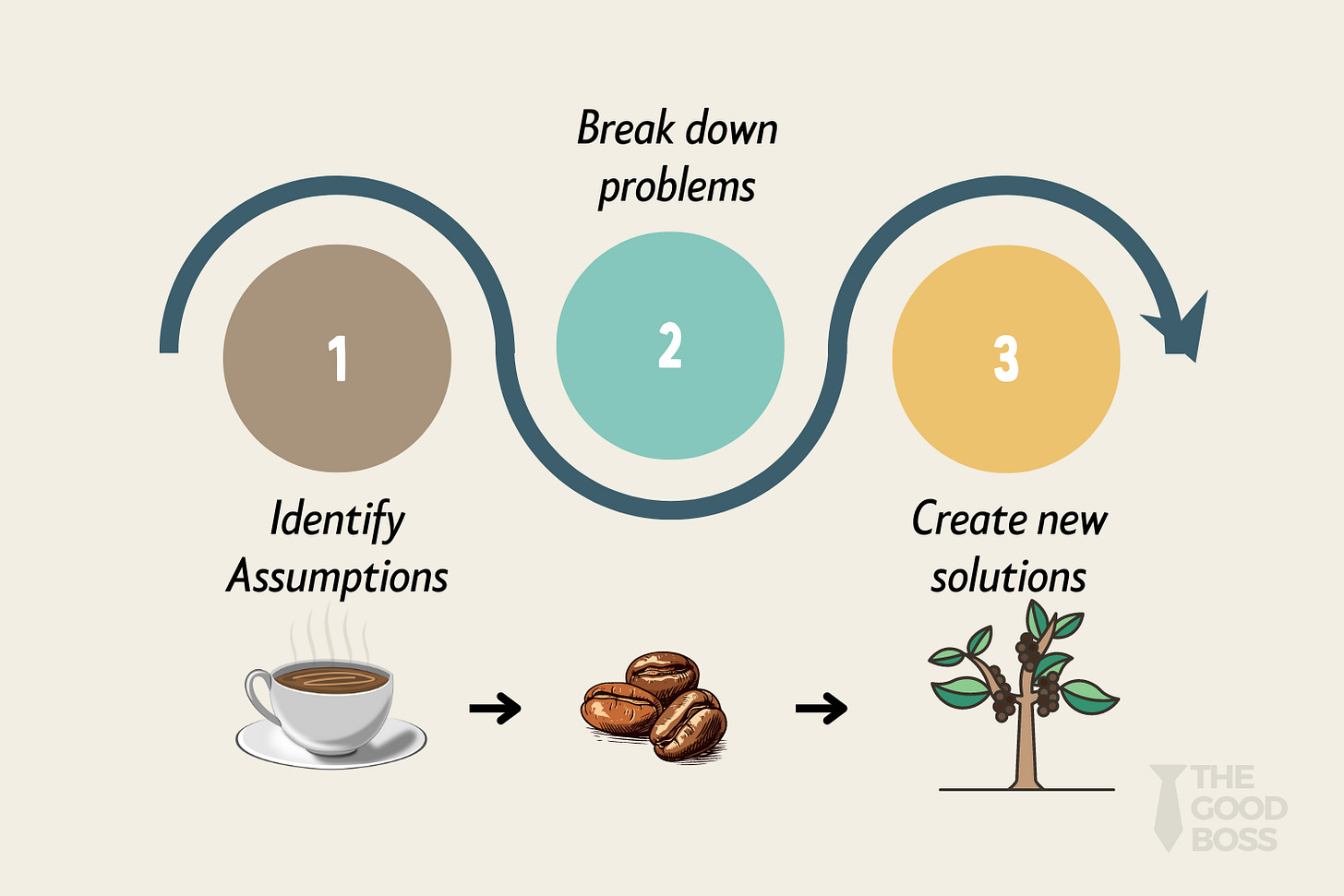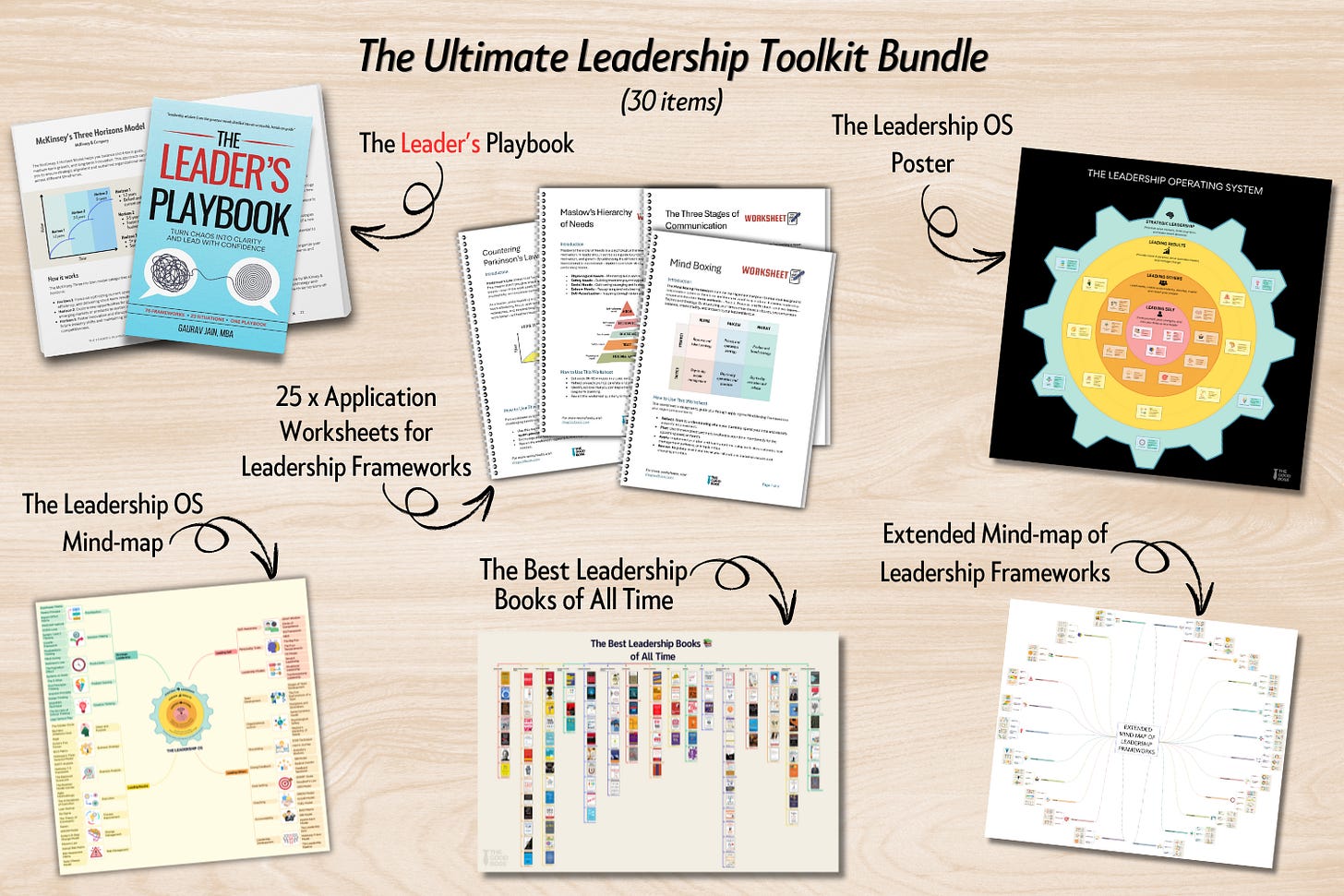5 Mental Models That Will Take Your Leadership from Good to Great
The Cognitive Tools You Need In Your Backpack
There are good leaders. And then there are great leaders.
We all know that managers need to show up, manage a team, and make decisions.
But leadership is much more than that. Leaders need to manage stressful situations, navigate ambiguity, and drive results while providing the support and growth their teams need.
According to a 2019 McKinsey study, companies with high-performing leaders are 1.9 times more likely to deliver above-average financial performance. However, the hard reality is that many leaders struggle when presented with high-pressure situations. A survey by Harvard Business Review found that 87% of executives admit that they face decision fatigue.
So, the key differentiator between good leaders and great leaders is how they think. That’s where mental models come in. Mental models are powerful tools that leaders can use to shape how they approach problems, and make decisions.
In this article, I’ll share five mental models that can take your leadership from good to great. These are the same tools that some of the world’s most successful leaders use to cut through chaos, lead with clarity, and get results.
Let’s dive in.
1. First Principles Thinking: Get to the Root
What’s the biggest problem you’re facing right now as a leader? Is it something that feels overwhelming, like it has layers upon layers of complexity?
Most problems can seem complicated, but the secret to solving them lies in breaking them down to their most basic elements. That’s where First Principles Thinking comes in.
What is First Principles Thinking?
At its core, first principles thinking is about stripping down a problem or challenge to its fundamental pieces.
Instead of asking, “How do I solve this problem”, you should ask, “What is this problem really made of?”
Did you know that Elon Musk famously applied this mental model when he questioned the cost of rockets, which eventually led to the creation of Space X? Instead of accepting that rockets were expensive because “they always have been,” he asked, “What are the core components of a rocket, and how can we make them cheaper?”
Why Does It Matter?
As a leader, if you adopt first principles thinking it can give you a fresh perspective and uncover solutions that you may otherwise never discover. By focusing on the most fundamental truths of a problem, you eliminate unnecessary complexity and get to the root of the issue. This allows you to focus on more creative and innovation approaches to solving problems.
How to Apply It
Think about a process in your team that has been in place for years. Do people just follow it because it’s how things have always been done? Now, try this: break that process down into steps and ask “What is the purpose of this step?” For example, if your team has always been following the Waterfall model for execution, you may find that there are potential issues with the steps and opportunities for your team to challenge long-held assumptions and improve the process.
As another example, let’s say your team struggles with hitting deadlines. Instead of just assuming that more time or more resources will fix the problem (which most managers would do), ask yourself: What are the core reasons we’re missing deadlines? Is it a communication issue? A resource allocation problem? Or is it something deeper, like a mismatch between task complexity and team skills?
Ask Yourself:
Am I solving this problem based on assumptions or fundamental truths?
Have I questioned the way things have always been done in my team?
When you start thinking in first principles, you’ll be surprised at how many “complex” problems suddenly become more manageable — and even solvable. Long-held assumptions will suddenly get exposed, and lead to a more creative and innovative solution.
2. Inversion: Think Backward to Move Forward
As humans, we are typically motivated to put our energies towards things we should do.
Have you ever taken a step back and thought about what not to do? It’s a common trap for leaders — we tend to focus so heavily on success that we fail to see potential pitfalls. That’s where Inversion comes in.
What is Inversion?
Inversion is the idea of thinking backward. Instead of asking, “How do we achieve success?” you ask, “How do we avoid failure?”
This mental model forces you to look at problems from a different angle, helping you identify risks and prevent mistakes before they happen. Charlie Munger is a big advocate of this model. He often says, “All I want to know is where I’m going to die, so I’ll never go there.”
Why Does It Matter?
A Gallup study found that only 21% of employees strongly agree that their leaders have a clear plan for avoiding mistakes. By using inversion, you can uncover blind spots and be better prepared to handle threats and have a mitigation plan.
How to Apply It
Let’s say you’re launching a new product. Instead of asking, “How do we make it a success?” try asking, “What would cause this launch to fail?” Maybe it’s poor communication with the customer, a misjudged market need, or technical flaws in the product.
Now, make a list of all those potential setbacks, and jot down a plan to mitigate each one of them. That will lead you to a solid plan that is less likely to fail.
Ask Yourself:
What’s the likely way this project could fail, and how can I prevent it?
How can I put the guardrails to avoid failure?
Inversion helps you see what could go wrong before it does, making you a more effective, forward-thinking leader.
3. The Map Is Not the Territory: Stay Flexible
I have always been a compulsive strategizer. I need a plan for everything: from managing my work day, to a vacation, or even a short commute to the grocery store. And if things go awry, or I’m not able to execute according to my plan, it makes me miserable. After all — I had the best plan, and it had to work, no?
Here’s the thing: just because I’ve mapped out a strategy doesn’t mean it’s the right one. This is where The Map Is Not the Territory mental model comes in.
What is The Map Is Not the Territory?
This mental model highlights the gap between your perception (the map) and reality (the territory). It reminds leaders that no matter how well-planned your strategy is, it’s only an approximation of reality.
Things change. New information comes in. The forces are different. The people are different. A strategy that worked last year might not work this year.
Why Does It Matter?
A study by Harvard Business Review found that 70% of strategic initiatives fail due to poor execution and a lack of adaptability. Leaders who cling too tightly to their initial plans often miss opportunities to pivot or improve.
You need to recognize that your “map” isn’t perfect, and should remain flexible and open to change.
How to Apply It
Say your team is following a marketing strategy that worked well in the past, but it’s no longer delivering results. Instead of sticking to the outdated map, ask yourself, “What’s changed in the market? What new data do we have?”
Adjusting your strategy to align with the current reality allows you to course-correct and remain relevant.
Ask Yourself:
Am I too attached to my original plan?
How accurate is my map? What new information am I ignoring that could change our course for the better?
Staying flexible and recognizing when it’s time to redraw your “map” is key to long-term success as a leader.
4. Occam’s Razor: Simplify Decision-Making
Many of us are perfectionists. Me included.
I often tend to overcomplicate decisions. I remember once when we had to make the decision about buying a property in Singapore, I made a detailed spreadsheet with all the data I could find — real-estate predictions in Singapore, rental yields, locality ratings, master plans and future constructions, interest rates, etc. — and wrote out dozens of formulas to guide our decision. When I proudly presented my spreadsheet to my wife, she glanced at it and said: “We just need a house to live in.” I didn’t look at the spreadsheet again.
It’s easy to get caught in the weeds as a leader, trying to consider every possible angle before making a call. But sometimes, the simplest solution is the best. That’s where Occam’s Razor comes in.
What is Occam’s Razor?
Occam’s Razor is the idea that the simplest explanation or solution is often the correct one. It encourages leaders to cut through unnecessary complexity and focus on the most straightforward approach or solution. In fact, research from Bain & Company shows that businesses that simplify their decision-making processes are 12% more likely to outperform competitors.
Why Does It Matter?
As a leader, decision fatigue is real. A 2017 study found that the average executive makes over 70 decisions a day, and with every additional decision, your ability to make good choices declines.
Simplifying your decision-making not only saves your time but also reduces the mental strain you go through, allowing you to focus on what really matters at work and in your personal life.
How to Apply It
Next time you’re faced with a complex decision, ask yourself, “What’s the simplest, most direct way to achieve the outcome I want?” For example, if your team is struggling with low productivity, you might be tempted to create new processes or hire more staff. But perhaps what you really need to do is to meet your team more regularly through a weekly team meeting, and help them make execution decisions.
Ask Yourself:
Am I overcomplicating this decision?
Is there a simpler solution that I’m overlooking?
Occam’s Razor encourages you to keep things simple and efficient, ensuring that you and your team can focus on what really drives success.
5. The Pareto Principle: Focus on the Vital Few
Have you had those days where you got a ton of things done, but at the end of the day you still feel like you didn’t accomplish much?
That’s because in most cases, only a small percentage of your efforts drive the majority of your results. This is the essence of the Pareto Principle, also known as the 80/20 rule.
What is the Pareto Principle?
The Pareto Principle states that 80% of outcomes come from 20% of efforts. In leadership, this means that only a handful of your actions — your “vital few” — create the biggest impact, while the rest may be just noise.
Why Does It Matter?
According to a Harvard Business School study, time management is one of the top challenges for leaders, with many spending 41% of their time on tasks that don’t drive value. By focusing on the 20% that truly matter, you can maximize your impact without burning yourself out on low-value tasks.
How to Apply It
Think about your daily tasks. Which of them generate the most results? Are you spending enough time on those?
For example, if you’re managing a sales team, it’s likely that 20% of your clients drive 80% of your revenue. Instead of spreading your efforts thin, focus on nurturing those high-impact clients.
As another example, when you want to reward your team, identify the top 20% performers and ensure they are well rewarded, as they are likely contributing towards 80% of the overall team results.
Ask Yourself:
What’s the 20% of my work that drives 80% of the results?
Am I spending enough time on the tasks that truly matter?
By prioritizing the “vital few” tasks that yield the biggest outcomes, you’ll boost your productivity and lead your team more effectively.
Conclusion
Great leaders use mental models to guide their decisions. They use these models to reduce complexity and to make effective decisions.
Which of these mental models will you start using today to level up your leadership? Let me know in the comments!
References
Books
Principles: Life and Work by Ray Dalio. Discusses Dalio’s principles of decision-making and leadership, covering mental models like first principles thinking.
Poor Charlie’s Almanack: The Wit and Wisdom of Charlie Munger by Charlie Munger. Munger advocates inversion and other key mental models for thinking clearly.
The Model Thinker: What You Need to Know to Make Data Work for You by Scott E. Page. A detailed look into how using multiple mental models improves decision-making.
The Art of Thinking Clearly by Rolf Dobelli. A guide to mental models that help leaders simplify decisions and avoid biases.
The Leader’s Playbook: Turn Chaos Into Clarity and Lead With Confidence by Gaurav Jain. Summarizes 75 leadership models that managers can apply to improve their effectiveness as leaders.
Articles
A Leader’s Framework for Decision Making by David Snowden and Mary Boone — Harvard Business Review
Productivity Is About Your Systems, Not Your People — Harvard Business Review
First Principles: Elon Musk on the Power of Thinking for Yourself — James Clear
Tackling Complexity: How to Create Simple and Effective Organizations — Bain & Company
TED Talks
The Power of First Principles Thinking by Elon Musk (Interview). Musk discusses his application of first principles thinking at Tesla and SpaceX.
The Surprising Habits of Original Thinkers by Adam Grant. Grant discusses how unconventional thinking and mental models drive leadership.
Podcasts
The Knowledge Project by Shane Parrish (Farnam Street). Focuses on how mental models improve decision-making in leadership. Start with the episode “The Mental Models I Use Daily.”
The Tim Ferriss Show — Episode 246: Ray Dalio on Principles and Decision-Making. Dalio explains the use of first principles and the Pareto Principle in his decision-making.
The Leadership Lab Podcast — Episode 72: Simplifying Leadership with General Stanley McChrystal. General McChrystal touches on Occam’s Razor and the importance of simplicity in leadership.
Freakonomics Radio — When to Rob a Bank and Other Leadership Lessons. Discusses unconventional thinking and how inversion as a mental model impacts decision-making.
The Ultimate Leadership Toolkit Bundle 🛠️
Ready to take your leadership to a whole new level? Unlock the full power of the best leadership frameworks and tools with The Ultimate Leadership Toolkit Bundle! From application guides to mind-maps to posters to worksheets and much more - this is your ultimate leadership resource!
👉🏼 Grab your copy of the bundle
🎁 Paid members: Claim your FREE access to the bundle (worth $210+) by using the exclusive coupon code mentioned on this page. Not a paid member? You can upgrade here.
👋🏻 Let’s stay in touch - connect with me on LinkedIn.
PS: If you’re enjoying The Good Boss, will you take 2 seconds and hit the ❤️ button and share/restack 🔁 it with others who might find it helpful? It goes a long way in helping me grow the newsletter. Thank you!
If you are not already, subscribe to The Good Boss for free articles like this every week. Consider becoming a paid subscriber to support my work, and get access to a host of premium articles, templates, and other leadership resources.











Excellent article! I will apply in my daily activities.